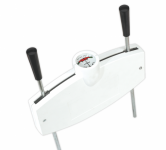Solar is probably not topping up the starter
battery: few do. 2-3 weeks of storage might be enough to run down a good
battery, depending on how much power is used in the background (alarm, tracker, ecu, radio memory etc etc)
This test does measure one aspect of a
battery, and can flag up a serious problem. Fail this test and a starter
battery is due for replacement.
Note that this test is not suitable for a habitation
battery, and failing this test should not write off a habitation
battery.
However, a
battery can pass this test and still be no use at all. So, no, you can't be sure that the
battery is OK.
A starter
battery has to accept a large quantity of power. It has to store that power. It has to deliver that power at a high current for a short time (to run the starter) and lower current for a longer time (lights, ignition etc).
The three main faults that can appear in a
battery are:
1. The
battery's capacity can fall. This normally happens gradually, but some faults make it happen quickly.
2. The
battery's ability to store the power can be impaired by faults in one or more of the cells.
3. The internal resistance of the
battery can rise. This will undermine its ability to provide a high current to the starter.
Basically, the tester only measures the
battery's ability to provide a hefty starting current. That's basically a matter of measuring its internal resistance under load.
Years ago, this was done using a metal strip effectively almost short-circuiting the
battery and measuring the voltage under that load.
Because this test would finish off a fading
battery, and because it was extremely dangerous to the operator (flammable gases, large sparks and corrosive acids don't go well with human faces), this sort of tester is no longer used.
Nowadays the thing that looks like a multimeter does more or less the same thing, but it only takes the high current for an extremely short time, and not until after the connections are securely made.

